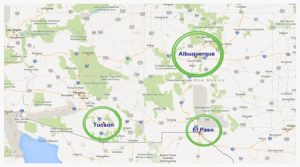 By: Ajay Madhvani, MAI, AM Valuation Services, PLLC, in Tucson
By: Ajay Madhvani, MAI, AM Valuation Services, PLLC, in Tucson
(August 4, 2023) — This report aims to show the strengths and weaknesses of Tucson, Arizona, and its sister cities, namely Albuquerque, New Mexico, and El Paso, Texas. This trio is a sisterhood, as they have many commonalities, including climate and population size. They also all share the distinction of a military base and a university. The statistics and data shown herein illustrate the big picture and may not reflect exact figures. Since our last publication in October 2017, much has changed. These changes include but are not limited to a global pandemic, legal changes, including the recreational and medicinal use of marijuana, and two new U.S. Presidents.
Tucson, Arizona
Tucson is about 60 miles north of the US-Mexico border and about 100 miles south of Phoenix, Arizona. The metropolitan population is about 1.04 million, but the 2020 US Census Bureau reports a population of about 543K. Major industries in Tucson include defense/aerospace, healthcare, and mining. Tucson has a minor league hockey and soccer team and an arena football team, but the most followed teams are associated with the University of Arizona. The current real estate trends include the build-up of downtown with new multi-family developments, street-car transportation, student housing, hotels, restaurants, and retailers. In 2019, work was completed on a $50 million, 150,000-square-foot regional headquarters for Caterpillar Inc. in Downtown Tucson. This space accommodates over 700 employees and has been a growth catalyst for the city.
Tucson has also become a distribution hub for Southern Arizona with the Port of Tucson. The Port of Tucson is a full-service inland port, rail yard, and intermodal facility. The port comprises 767 acres with 50,000 linear feet of rail track, with cold storage, dry storage, distribution, and manufacturing. There are four Amazon facilities in the Tucson area: the 857K SF Fulfillment Center built in 2019, the 49,500 SF “Last Mile” facility, the 270K SF Delivery Station, and the newest is a 220K SF facility in Marana. The Marana facility has been completed but is still vacant. Potentially, there is a large copper mine to the southeast of Tucson, but this has been pending for several years, awaiting county, state, and federal permits. There are also plans by American Battery Factory to construct a 2 million SF lithium iron phosphate battery plant, which will create 300 jobs at the onset and will be scaled up to a thousand jobs. Sion Power Corporation, a Tucson-based battery developer for electric vehicles, signed a pair of leases totaling 212K SF. The expansion is expected to be complete by 2026 and will create over 150 high-quality jobs. Shamrock Foods also acquired 81 acres for a distribution center in Marana.
An ongoing issue with Tucson, as well as the other two cities, is water availability. Tucson is heavily dependent on the Central Arizona Project (CAP) canal for water, which may be less available in the long-term with ongoing cuts from long-term droughts and over usage. However, the water table is currently up from prior years, with an estimated 5.5 years of excess Colorado River water in aquifers. Other options will have to be visited soon for Tucson to grow sustainably.
The major difference between Tucson and its sister cities is that it is in the shadow of a much larger city. The Phoenix metropolitan area is about 5 million people and has sports venues, a much larger international airport, corporate industries, loop freeways, and a light rail line. This is both a benefit and a detriment to Tucson. It could be seen as a detriment since the state and corporations focus their time and energy on the greater Phoenix area.
Albuquerque, New Mexico
Albuquerque is about 300 miles north of El Paso, 400 miles northeast of Phoenix, Arizona, 400 miles south of Denver, 450 miles northeast of Tucson, and 600 miles east of Las Vegas. The metropolitan population is about 924,000, and the 2020 US Census Bureau reports a population of about 565K. Major industries in Albuquerque include Defense/Aerospace, Bioscience, Renewable Energy, Digital Media and Film, and Manufacturing.
Albuquerque is the hub of New Mexico and has a rich culture. The city has a strong central downtown core, four seasons, minor league baseball, hockey, and soccer teams, and an indoor football team. Like Tucson, Albuquerque has a revitalized convention center known as Tingley Coliseum. Two interstates, also like Tucson, serve Albuquerque. The city has similar water issues like Tucson, but the water table is up from past years due to active water conservation and reclamation efforts.
Albuquerque has a commuter rail line, known as Rail Runner, traveling north-south from Belen, through the city, and to Santa Fe, about 60 miles to the north, and the Albuquerque Rapid Transit (ART). The Rail Runner and ART connect metro Albuquerque, visitors, and residents to various destinations throughout the area. New developments continue on the west side of the city. The city generally grows to the west, given the surrounding public lands and geography of the land to the north and east. Downtown 2025 is an initiative in Albuquerque. The goal is “To make Downtown Albuquerque the best mid-sized downtown in the USA.” There are many strategies for Downtown 2025, including enhancing the character of the neighborhoods, maintaining downtown as the largest employment center in New Mexico, and making downtown a tourist destination.
Albuquerque has recently added a 2.8 million SF Meta/Facebook Data Center for newer employment opportunities and a 441K SF Amazon Fulfillment Center completed in mid-2021. There is a proposed 257k SF Netflix production facility.
El Paso, Texas
El Paso, Texas, is about 300 miles south of Albuquerque and 300 miles east of Tucson. The city’s metropolitan population is about 869,000, and the 2020 US Census Bureau reports a population of about 679K. Major industries in El Paso include manufacturing, data centers, renewable energy, sustainable industries, and transportation and logistics. The El Paso economy is largely based on how well and how safe Ciudad Juarez is at any given time. El Paso also benefits from its vicinity to the border, and despite its rowdy neighbor Juarez, El Paso is one of the safest cities in the United States.
Recent trends in El Paso include a downtown that is being revitalized with new hotels, housing options, mixed-use developments, a baseball stadium, and a repurposing of buildings. The El Paso Streetcar opened in 2018. This project runs about 5 miles from downtown to the university in restored streetcars. The city is growing on the east and west ends with new residential and retail developments. There is also a proactive local developer who has been repurposing historic properties throughout the city. The area near Fort Bliss is also seeing new retail and residential development. El Paso is also ahead of the curve regarding water treatment, as the city is utilizing a desalination plant. The desalination plant is the world’s largest inland desalination plant and can produce up to 27.5 million gallons of fresh water daily. The water is drawn from the nearby Hueco Bolson. Overall, the market appears to be steadily growing and improving.
El Paso has become a logistics hub for newer employment opportunities, and exports have grown 210% over the past decade. El Paso also has a 2.6 million SF Amazon Fulfillment Center completed in 2022. In addition, Hunt Companies recently delivered a speculative 262K SF, 20-story, Class A office tower, the first in 30 years in El Paso.
Population Statistics
The populations of the three metropolitan areas are similar. However, the 2020 census numbers are much lower. This is simply the result of city limits. Tucson is 241 square miles, Albuquerque is 190 square miles, and El Paso is 256 square miles. All three cities are spread out, accounting for the large difference in metropolitan population versus census figures. The population of each city is shown in the following table.
Population Growth
The populations of all three cities have grown by a small amount from 2020 to 2022. Albuquerque and Tucson have grown at a generally similar pace of 0.3% and 0.5% annually, while El Paso has grown faster at 2%. Tucson and Albuquerque grew faster from 2010 to 2020, at 0.38% and 0.65%. At the same time, El Paso grew at 0.81% annually.
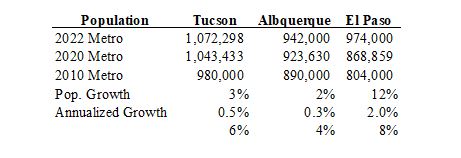
Median Household Income
The U.S. median household income was $70,784 in 2021. All three cities have a lower median household income than the national median. Fortunately, all three cities have posted an increase in median household income from 2017. The lower wages are attributed to the vicinity of the border and inexpensive living costs. Unfortunately, there are also concerns with high rates of poverty in all three cities.
Top 10 Employers
The top 10 employers in Tucson accounted for over 69K jobs in 2020. In Albuquerque, the top 10 employers account for over 83K jobs in 2023, and for El Paso, about 93K jobs. The El Paso figures are from 2016. As of the city’s reporting, this is the newest available data, as new figures are not yet public. A military base is one of the top 3 employers in each of the sister cities, and governmental entities account for most of the jobs. Of the three cities, Tucson has the most private employers in the Top 10, with Raytheon, Banner, Freeport, and Wal-Mart. In addition, the Intel Corp. figure for Albuquerque of 3,500 in 2017 is also much smaller in 2023, by approximately 2,000 employees. El Paso has the largest number of public employers, with Tenet Hospital Ltd being the only private employer in the Top 10.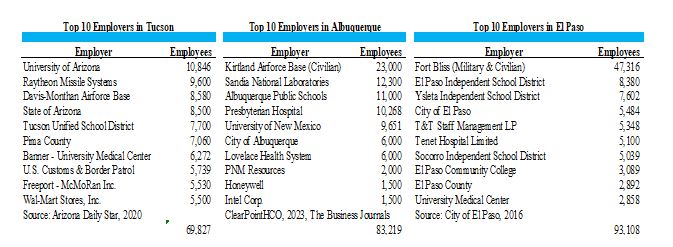
The top 10 employers account for 15% of the total workforce in Tucson, 19% in Albuquerque, and 26% in El Paso. Tucson has the largest number of employees, followed by Albuquerque, then El Paso. This is a significant shift from May 2016, when Tucson had about 297,560 employees, Albuquerque had 381,570, and El Paso had slightly more than Tucson, at about 302,000. Generally, the number of employees correlates with each city’s population. The Tucson labor force is considered less risky than their counterparts since the top 10 employers account for the fewest number of total jobs.
Student Population
All three cities have a State University, significantly impacting the local economy. The University of Arizona (UA) is the largest of the three, impacting the local economy and politics. The University of New Mexico (UNM) and Texas at El Paso (UTEP) also significantly impact their respective communities. From the 2017-2018 academic year, the UA has grown the 20%, while UTEP had minimal growth of 2% and UNM declined by 19%. The table below shows the enrollment of the three universities for the 2022-2023 academic year.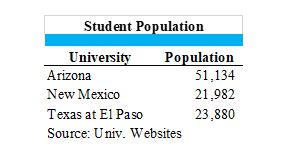
New Home Permits
The number of new home permits includes single-family and multi-family residences. Tucson shows much higher new home permits for 2022. Albuquerque and El Paso show generally similar new home permit figures.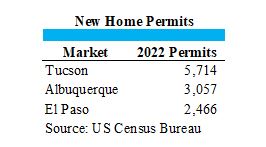
Airport Statistics
The three airports vary greatly in arrival/departure statistics. The main reason Albuquerque’s traffic volume is much higher than Tucson and El Paso is that the city is distant from surrounding metropolitan areas. Albuquerque also receives more tourists traveling to nearby cities in the northern part of the state, including Santa Fe and Taos. Tucson posts smaller figures since it is close to Phoenix’s airport, which has more travel options and often offers lower prices. The airport traffic statistics are shown in the following table. 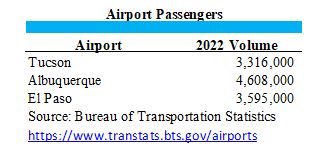
Building Type Breakout
Next, we will discuss each city’s hotel, apartment, industrial, office, and retail markets. This discussion will illustrate each community’s strengths and areas for improvement.
Hotel
The Covid-19 pandemic greatly impacted the hotel sector across the nation, and it is still recovering from the effects of the pandemic. In addition, new rental options such as Airbnb, VRBO, and other online options have become significant competitors to the conventional hotel market. The hotel room statistics in Tucson and Albuquerque are generally similar with room count and occupancy. The El Paso market, by far, has the most available rooms, primarily due to its location on the US-Mexico border. All three cities are adding new rooms, which suggests continued demand for conventional hotels in the three markets.
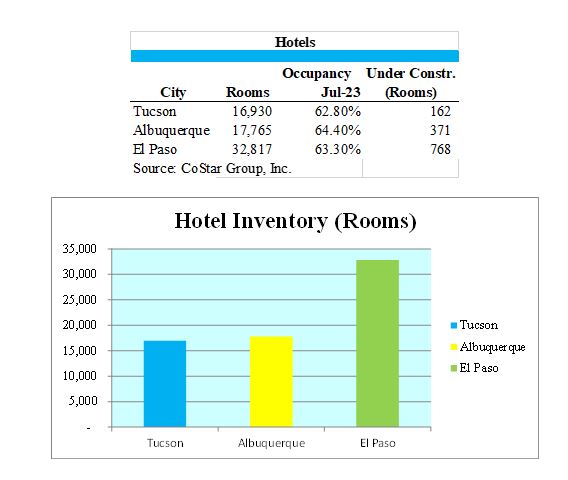
Apartments
The Tucson market has the most apartment units of the three markets by a large margin. Tucson could have the most units of the three markets for several reasons. Several factors can explain this. First, Tucson has the largest university of the three markets and the most extensive metro population of 1.04 million, versus 920K in Albuquerque and 870K in El Paso. Secondly, Tucson has the lowest median household income of the three markets at $48K, versus $56K in Albuquerque and $51K in El Paso. In the past, higher home prices in Tucson than in the other two markets could have spurred new apartment development to offer a lower-priced housing option, but this is currently not the case. According to Redfin, Tucson’s median home price is about $330K, versus $380K in Albuquerque and $300K in El Paso. In the past, rental rates in Tucson could have been higher than the other two cities, but this is currently not the case either. The average effective rent is $1,203 in Albuquerque, $1,015 in El Paso, and $1,137 in Tucson. Several new units are being constructed in Tucson and Albuquerque. El Paso also has the largest military base of the three markets, with housing options on the base. This could be why El Paso has the fewest units and the fewest being constructed. Another variable to consider is that Tucson is closer to large Phoenix and California developers than the other two markets, saving time and money for construction and shipping materials.
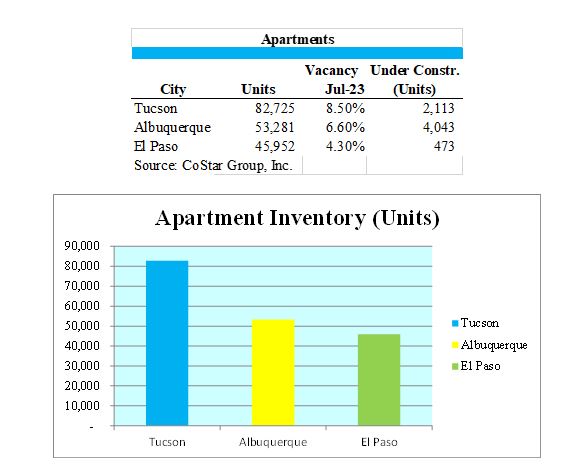
Industrial
The industrial market indicates manufacturing, production, distribution, and supply in a particular market. The table and graph below show that El Paso has the most significant industrial market. This is primarily due to the city’s location along the US-Mexico border. El Paso has become a logistics hub, and exports have grown 210% over the past decade. Albuquerque has the second-largest industrial market. This is because Albuquerque is distant from surrounding cities and, therefore, a more desirable geographic location for the distribution hubs and supply centers between more prominent cities in the western United States, such as Los Angeles, Denver, Phoenix, and Oklahoma City. Albuquerque has recently added 2.8 million SF Meta/Facebook Data Center, 441K SF Amazon fulfillment center, and 257K SF Netflix production facility. Tucson has the smallest industrial market primarily due to Phoenix being 100 miles to the north with a larger population, airport, and surrounding cities. All three cities have grown from 11%-15% from 2017 to 2023. El Paso added over 9 million square feet, and Albuquerque grew about 15% with over 7.5 million square feet of new space during this time. Tucson also added about 4.6 million square feet of new industrial space. Since 2017, four Amazon facilities have been completed in the Tucson area: the 857K SF Fulfillment Center built in 2019, the 49,500 SF “Last Mile” facility, the 270K SF Delivery Station, and the newest a 220K SF facility in Marana. The Marana facility is complete but still vacant. The vacancy rate in all three cities has significantly declined, especially in Tucson, which was 8.30% in 2017 and now is 3.40%. The vacancy in Albuquerque dropped from 2.90% in 2017 to 1.50% in 2023, while El Paso’s rate dropped from 8.30% to 6.0%. New facilities are being constructed in all three markets, showing continued demand for industrial space in all three markets.
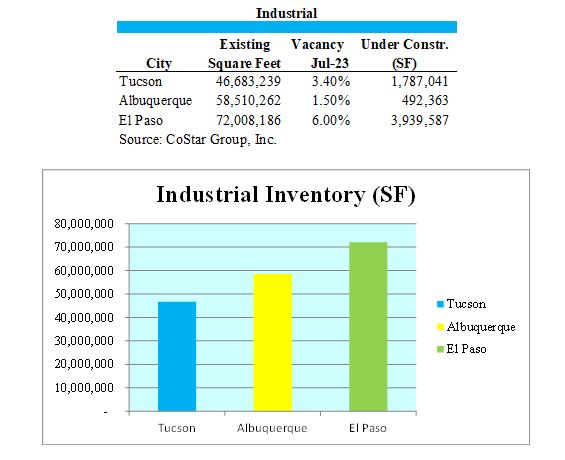
Office
The office market represents the corporate and small business market, financial strength, and city production. The Covid-19 pandemic has drastically changed the office market, with more people working remotely from home than ever. Albuquerque has the most prominent office market of the three cities. Once again, this is due to Albuquerque serving as a hub for New Mexico. Tucson has a smaller office market due to Phoenix serving the large corporations in the region. El Paso has the smallest office market, but Hunt Companies recently delivered a speculative 262K SF, 20-story, Class A office tower, the first in 30 years in El Paso. Tucson’s office market has grown the most from 2017-2023, with about 2.97 million square feet of new space versus about 2.09 million square feet in El Paso and 1.48 million square feet in Albuquerque. The vacancy rate for all three cities varied during this time, with Albuquerque declining from 7.4% in 2017 to 4.9%. The vacancy rate in Tucson for 2023 was 9.8%, the same as in 2017, while El Paso’s rate increased from 5.4% to 5.9%.
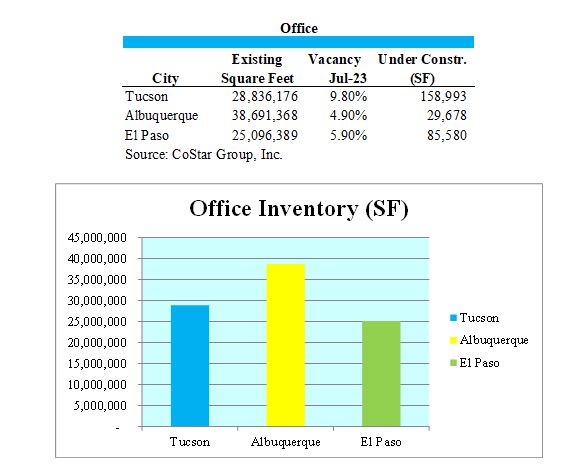
Retail
The retail market represents expenditure income, tourism, and contributions related to retirement and student populations. Notably, a large influx of shoppers from Mexico seeking higher-end products and a ‘shopping experience’ in all three cities, but primarily in El Paso and Tucson. Albuquerque has the largest retail market of the three cities. Once again, this is due to Albuquerque serving as a hub for New Mexico. Tucson has a similar-sized retail market due to Tucson’s vicinity to the US-Mexico border and the significant retirement and student populations. El Paso has a smaller but similar-sized retail market due to El Paso’s vicinity to the US-Mexico border. El Paso’s retail market has grown the most from 2017-2023, with about 4.08 million square feet of new space. Tucson reports similar growth at 4.05 million square feet and 2.39 million square feet for Albuquerque. The vacancy rate in all three cities has declined, with Albuquerque showing the most significant drop of 1.9%. The vacancy in Tucson dropped from 6.2% in 2017 to 5.6% in 2023, while El Paso’s rate dropped from 3.8% to 2.8%.
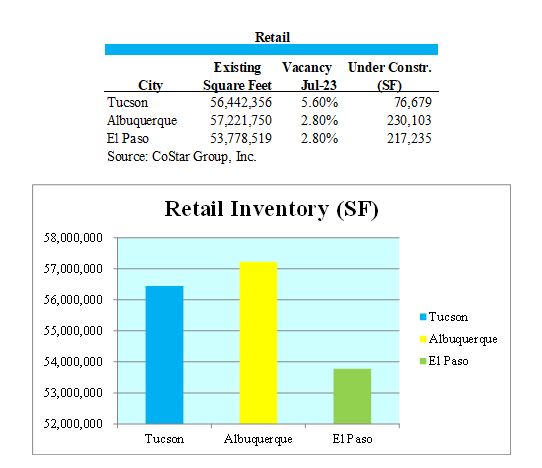
Conclusions
The three cities serve a similar demographic population: military personnel, students, and retirees. The communities are similar in size and, unsurprisingly, have similar-sized industrial, office, and retail markets. The hotel and apartment sizes vary between the three markets. All three cities have a downtown that is under revitalization, a civilian rail transportation system that was recently completed or under construction and are actively managing water concerns. The markets are operating in a period of slow but steady growth.
Statistically, Albuquerque has the best geographical position and capitalized on its strengths. Albuquerque has low vacancy rates across the five property types analyzed but has also been slow to add inventory. Albuquerque also has the three cities’ highest airport volume and median income. Overall, Albuquerque benefits from being the hub of New Mexico, having good weather, and having low vacancy rates for the three major property types.
Tucson has done an excellent job of catering to the university market and now has the most significant employment base of the three cities. Because Tucson is the largest of the three cities and has the largest university of the three cities, it has the potential for a more educated community. Tucson benefits from its vicinity to the border and could also further benefit from its vicinity to Phoenix, especially if Tucson had a connecting light rail system. Tucson could serve as a warehousing market for Phoenix companies; for example, it could offer more minor league sports and training programs to support the professional teams in Phoenix. Tucson could improve on catering to industry and collaborating with Phoenix. Tucson could further offer tax incentives, political cooperation, and improved infrastructure to cater to existing and potential employers. Tucson has excellent potential for growth with a large population base and student population, but it is in the shadow of a larger city.
El Paso has captured the US-Mexico border business, such as cold storage and retail while catering to large manufacturers and distribution centers to grow local jobs. The city’s safety is also appealing for growth and existing citizens. Overall, El Paso has capitalized upon its location along the US-Mexico border and its large military base and is well positioned in the market.
Although all three cities are similar metropolitan areas, they have distinct strengths and weaknesses. A long-term trend for all three cities could be concerning in the future. The growth rates for all three cities have slowed down from 2000-2010. The three markets highlighted received an influx of people during the pandemic. However, there are population shifts back to larger cities. These larger metropolitan areas attract young professionals because they offer more job opportunities, amenities, and a greater variety of services. This trend could change, as these three sister cities offer sunny weather, affordability, and outdoor activities and are less likely to be impacted by natural disasters. These three cities could also market their strengths better to attract younger talent.
Recommendations
The three sister cities may already follow these recommendations, but there is no harm in repeating them. The cities could coordinate with one another and build alliances to serve as a network for manufacturing and distribution. For a city to be appealing, the fundamentals must be addressed. These fundamentals include safe and clean living, good education, and vital youth programs. Unfortunately, homelessness and mental health issues have intensified in all three cities, but this appears to be occurring nationwide. There is an ongoing challenge to address the problem, but it seems to be a symptom of our nation’s current society and needs to be addressed. A cooperative legislation and political system with the community and surrounding communities is also crucial for all three cities.
The cities could also have water issues going into the future, so this could be an opportunity for the cities to team up with each other to deal with the problem creatively. The cities will likely be reusing (not recharging) their water in the future, so the sooner the infrastructure is in place, the better. El Paso appears ahead of the other two cities in this regard, but it is still better to have diverse and varied water-sourcing options. Another option would be to pipe in water from an area with surplus water or desalinate water in the nearby Gulf of Mexico and construct a pipeline from there. The cities could invest in a pipeline structure together. Water harvesting programs and incentives could also be implemented in each city.
Lastly, these sister cities could offer better infrastructure. The core of each city would benefit from underground electricity lines, public transit systems, adding more efficient routes, and nicer roads. All three cities benefit from a high number of sunny days. Large-scale solar energy has been in progress for all of the sister cities but will only continue to grow with public support. There are also “mechanical trees” that remove carbon dioxide from passing air that could be utilized in all three cities as temperatures quickly rise in the region. The city’s overall value would increase by building and expanding its fiber optic and Wi-Fi networks. Water will be a continuous battle in the southwest, so adding water harvesting, gray water lines, and reclaimed water lines to golf courses, car washes, and parks will be helpful as we advance. Improving the educational systems, individually or collectively, between the cities promotes responsible growth, infrastructure, and maintenance of the unique culture of each community. Preserving and promoting art and culture is also essential to include in the infrastructure of these historically and culturally rich cities. Art districts, murals, and other creative projects are an important and often overlooked part of a city’s infrastructure. All these factors would improve the city’s appeal to employers, families, students, young professionals, and retirees.
This analysis aims to show the strengths and weaknesses of the three sister cities. The primary goal is to help achieve an improved quality of life for each. The secondary goal is to have a long-term sustainable future and grow regional demand. Growth is typically perceived as a positive thing. However, thoughtful growth, a long-term plan serving a greater purpose, provides even more significant regional benefits.
Summation of Sister City Key Comparison Take-Aways
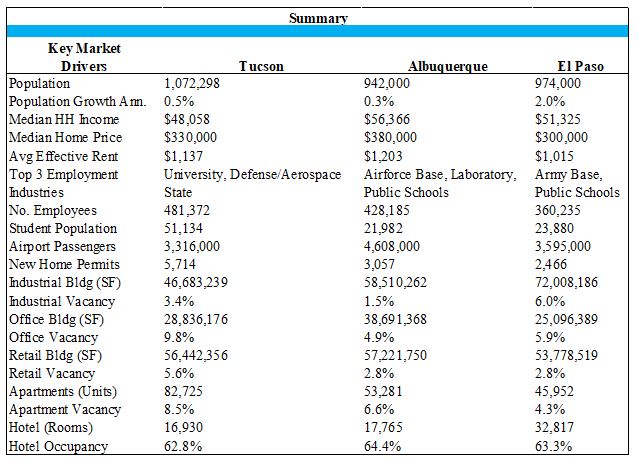
 Ajay S. Madhvani is the owner of AM Valuation Services, PLLC and has been a commercial real estate appraiser since 2004. Ajay has experience in commercial property types, including multi-family, industrial, retail, office, residential subdivisions, land, tribal land, self-storage, and several other types of commercial real estate. Ajay has also performed large project appraisals on tribal lands throughout the southwest United States.
Ajay S. Madhvani is the owner of AM Valuation Services, PLLC and has been a commercial real estate appraiser since 2004. Ajay has experience in commercial property types, including multi-family, industrial, retail, office, residential subdivisions, land, tribal land, self-storage, and several other types of commercial real estate. Ajay has also performed large project appraisals on tribal lands throughout the southwest United States.
His book of clients includes banks, governmental entities, attorneys, and private corporations. Ajay is an MAI and a Certified General Appraiser in Arizona, New Mexico, and Utah. Ajay is also a former Director of the Southern Arizona Chapter of the Appraisal Institute. He obtained his bachelor’s degree in Business Administration from the University of Arizona’s Eller College of Management, with majors in finance and business management.
Ajay has experience throughout the State of Arizona, with primary experience in Southern Arizona and the Navajo Nation. Ajay is a designated member of the Appraisal Institute (MAI) and is licensed as a Certified General Real Estate Appraiser in the States of Arizona, New Mexico, and Utah. Ajay has experience in apartments, student housing, vacant land, subdivisions, office buildings, retail buildings, service stations, industrial buildings, mobile home parks, self-storage facilities, business site leases, and special-use properties. Ajay’s clients include private individuals, corporate organizations, banks, attorneys, and governmental agencies. Ajay has experience preparing reports for conventional lending, SBA, litigation work, eminent domain work, consultations, and appraisal reviews.
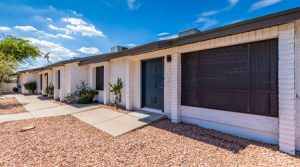 Phoenix, AZ. (December 15, 2023) – ABI Multifamily, the leading multifamily brokerage and advisory services firm in the Western US, is pleased to announce the $3,250,000 / $270,833 Per Unit / $288.12 Per SF sale of McKemy, a 12-unit multifamily apartment community located in Tempe, Arizona. ABI Multifamily’s Carson Griesemer, Dallin Hammond, and Mitchell Drake represented the buyer and seller.
Phoenix, AZ. (December 15, 2023) – ABI Multifamily, the leading multifamily brokerage and advisory services firm in the Western US, is pleased to announce the $3,250,000 / $270,833 Per Unit / $288.12 Per SF sale of McKemy, a 12-unit multifamily apartment community located in Tempe, Arizona. ABI Multifamily’s Carson Griesemer, Dallin Hammond, and Mitchell Drake represented the buyer and seller. Apache Junction, AZ (December 4, 2023) — It’s that time of year when those dreading the cold months start dreaming of traveling to places where it always feels like summer. Snow and chilly weather aren’t for everyone — and for snowbirds (of all ages), it’s the signal to pack up and head south.
Apache Junction, AZ (December 4, 2023) — It’s that time of year when those dreading the cold months start dreaming of traveling to places where it always feels like summer. Snow and chilly weather aren’t for everyone — and for snowbirds (of all ages), it’s the signal to pack up and head south. By: Ajay Madhvani, MAI,
By: Ajay Madhvani, MAI, 













 Ajay S. Madhvani is the owner of AM Valuation Services, PLLC and has been a commercial real estate appraiser since 2004. Ajay has experience in commercial property types, including multi-family, industrial, retail, office, residential subdivisions, land, tribal land, self-storage, and several other types of commercial real estate. Ajay has also performed large project appraisals on tribal lands throughout the southwest United States.
Ajay S. Madhvani is the owner of AM Valuation Services, PLLC and has been a commercial real estate appraiser since 2004. Ajay has experience in commercial property types, including multi-family, industrial, retail, office, residential subdivisions, land, tribal land, self-storage, and several other types of commercial real estate. Ajay has also performed large project appraisals on tribal lands throughout the southwest United States.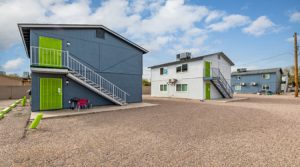 PHOENIX (April 13, 2023) –
PHOENIX (April 13, 2023) –  MARANA, ARIZONA, April 4, 2023 –
MARANA, ARIZONA, April 4, 2023 – 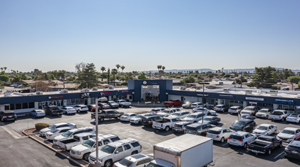 Phoenix, Arizona — Newmark announces it has completed the $6.25 million sale of Plaza 59, a 32,128-square-foot multi-tenant shopping center in Phoenix, Arizona. Newmark Senior Managing Directors Steve Julius and Jesse Goldsmith and Director Chase Dorsett represented the seller, Plaza 59, LLC (a Scottsdale-based private investor) in the trade to buyer 33rd Ave & Indian School Rd Pros RE, LLC. This represents the Newmark team’s second transaction working with the seller on this property.
Phoenix, Arizona — Newmark announces it has completed the $6.25 million sale of Plaza 59, a 32,128-square-foot multi-tenant shopping center in Phoenix, Arizona. Newmark Senior Managing Directors Steve Julius and Jesse Goldsmith and Director Chase Dorsett represented the seller, Plaza 59, LLC (a Scottsdale-based private investor) in the trade to buyer 33rd Ave & Indian School Rd Pros RE, LLC. This represents the Newmark team’s second transaction working with the seller on this property. By: Ian Turner of Commercial Industrial Arizona Advisors
By: Ian Turner of Commercial Industrial Arizona Advisors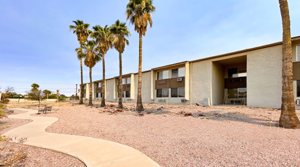 Phoenix, Arizona – ABI Multifamily, the leading multifamily brokerage and advisory services firm in the Western US, is pleased to announce the $3,800,000 / $48,718 Per Unit / $61.32 Per SF sale of Copper Heights Assisted Living in Mesa, Arizona. ABI Multifamily’s Carson Griesemer, Dallin Hammond, and Mitchell Drake represented the buyer and seller in this transaction.
Phoenix, Arizona – ABI Multifamily, the leading multifamily brokerage and advisory services firm in the Western US, is pleased to announce the $3,800,000 / $48,718 Per Unit / $61.32 Per SF sale of Copper Heights Assisted Living in Mesa, Arizona. ABI Multifamily’s Carson Griesemer, Dallin Hammond, and Mitchell Drake represented the buyer and seller in this transaction.
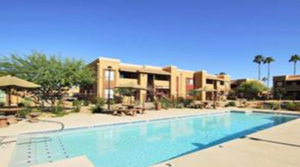 PHOENIX, AZ –
PHOENIX, AZ –